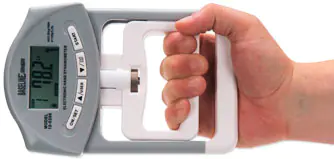Of particular interest when practicing athleticism is control over changes in muscle strength, carried out using medical devices - dynamometers of various designs.
Content- Medical hand dynamometer
- Method for determining strength - deadlift dynamometry method
- Method for determining the level of development of the shoulder muscles
- Alternative methods for determining and accounting for strength growth
Medical hand dynamometer
Manual dynamometer determine the strength of the hand muscles by moving the arm to the side. Two measurements are taken - alternately on each hand, and the best result is recorded. A special medical measuring device looks like hand expander, but not an ordinary one, but with a measuring board and sensor, and is intended not for cyclic training compressions, but for squeezing once with the maximum force possible for you... The results obtained should be entered into the self-monitoring journal…
A more objective indicator is the relative amount of muscle strength, since the increase in strength during training is closely related to the increase in body weight and muscle mass. For example, to determine the relative value of hand strength, it is necessary to take readings obtained in kilograms, which will be determined by a medical hand-held dynamometer, multiplied by 100 and divided by the athlete’s body weight. For untrained men this figure is 60-70, for women this index is 45-50%.
Method for determining strength - deadlift dynamometry method
Having calculated the power of your hands, there is a great way to check your results in such a comprehensive basic exercise as deadlift - this is where all your strength qualities will really be visible in the complex, because almost all the main muscles of the athlete’s body are involved in this movement. To determine strength, the method of backbone dynamometry is used in almost all dispensary institutions in our country. To do this, use a device that looks similar to a regular foot expander. The handle is for the hands, the footrest is for the feet, but instead of springs there is a cable with a measuring device in the middle. Your task is to pull the handle as hard as possible.
- I) less than 170%, it should be considered low,
- II) from 170 to 200 - below average,
- III) 200-230 - average,
- IV) 230-250 - above average,
- V) more than 260 - high.
An increase in relative strength indicators indicates an increase in muscle strength and, as a rule, an increase in the percentage of muscle mass.
Method for determining the level of development of the shoulder muscles
The development of the shoulder muscles can be determined by measuring the circumference of the shoulder, first with the arm freely lowered, relaxed (Indicator Y), then with the arm horizontally extended, tense and at the same time bent at the elbow (Indicator X). In both options, the maximum circumference is measured.
To evaluate the results obtained, you can apply the following ratio:
Z = (X-Y)*100/Y
- A Z value less than 5 indicates unsatisfactory development of the shoulder muscles and obesity;
- A value in the range of 6-12 indicates normal muscle development;
- A value over 12 indicates excellent development of the shoulder muscles.
Alternative methods for determining and accounting for strength growth
In the absence of a dynamometer, you can quite accurately determine the amount of strength endurance by performing pull-ups, flexion/extension of the arms in support (for example, on parallel bars or from the floor) and other exercises. The results obtained should be recorded in a diary, and then, as an option, once a quarter (2-3 months), repeat the procedure, observing the growth in the strength of the arms, legs and shoulder girdle.
The level of growth in strength qualities is often judged based on the results of execution. competitive or training exercises. Maximum strength corresponds to the greatest weight that an athlete can lift in a technically fairly simple movement (for example, a bench press).
Using complex coordination movements (barbell jerk) for this purpose is ineffective, since the indicator in them largely depends on the skill and technical mastery of the athlete.
When assessing muscle strength during self-control, it should be remembered that it directly depends on:
- a) age,
- b) gender,
- c) weight,
- d) type of training influences,
- d) degree of fatigue
- e) etc.
Strength indicators changes throughout the day: the lowest value is observed in the morning, and the highest in the middle of the day.
Decreased strength occurs when:
- a) feeling unwell,
- c) diseases,
- d) violation of the regime,
- d) negative mood
- e) etc.
It occurs after 40-50 years, especially in those who do not engage in physical education.
Systematic introspection allow you to think creatively about training, a healthy lifestyle, rationally and effectively use physical education in order to maintain health and strengthen the immune system, as well as to increase performance.
Post Views: 249


